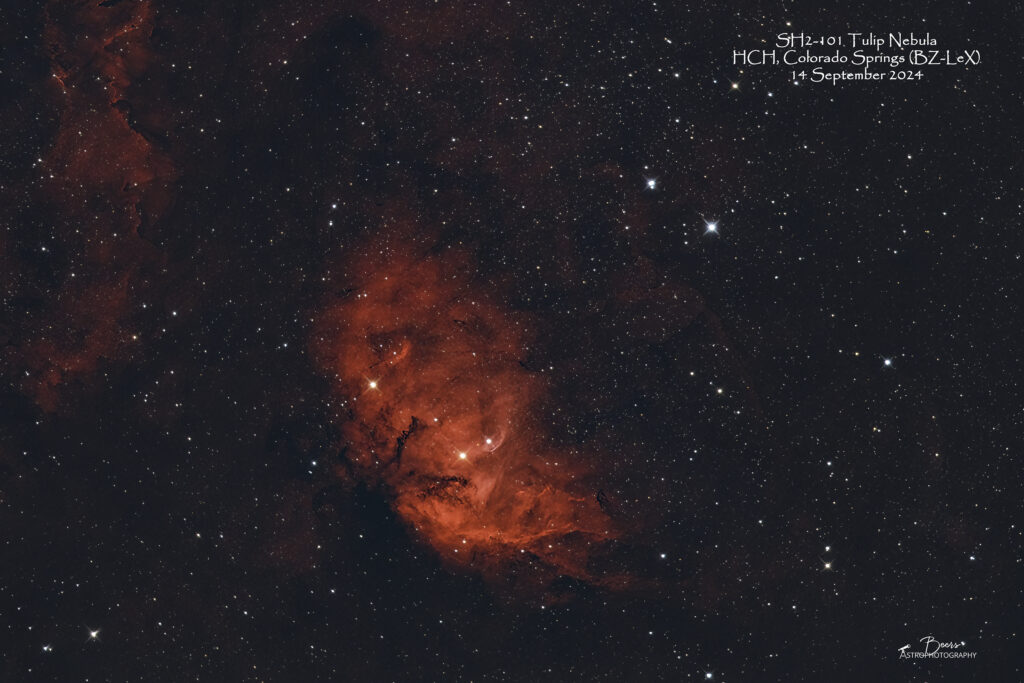
Fun facts
SH2-101 Tulip Nebula: Sharpless 101 (Sh 2-101) is a H II region emission nebula located in the constellation Cygnus. It is sometimes also called the Tulip Nebula because it appears to resemble the outline of a tulip when imaged photographically. It was catalogued by astronomer Stewart Sharpless in his 1959 catalog of nebulae. It lies at about 6,000 light-years (5.7×1016 km; 3.5×1016 mi) from Earth.
Sh 2-101, at least in the field seen from Earth, is near microquasar Cygnus X-1, site of one of the first suspected black holes. Cygnus X-1 is located about 15′ west of Sh 2-101. The companion star of Cygnus X-1 is a spectral class O9.7 Iab supergiant with a mass of 21 solar masses and 20 times the radius of the Sun. The period of the binary system is 5.8 days and the pair is separated by 0.2 astronomical units. The black hole has a mass of 15 solar masses and a Schwarzschild radius of 45 km. A bowshock is created by a jet of energetic particles from the black hole as they interact with the interstellar medium. It can be seen as an arc at the top of the photo on the left.
Other Catalog Designations: Sharpless 101, Sh 2-101, Cygnus Star Cloud
Subtype: HII region emission nebula
Distance from Earth: 6000 light years
Apparent Size: 16‘ x 9‘
Size: 15 light years (diameter)
Magnitude: 9.0
Constellation: Cygnus
{Target information derived from: https://en.wikipedia.org/wiki/Sh_2-101}
Capture & Processing Notes
As background, from my 6 September 2024 imaging of IC5146 Cocoon Nebula… The autoguider decided not to work reliably throughout the night. It would connect fine, conduct the calibration at the beginning of each sequence, pause during auto-focus (while I was watching it), and resume. But it stopped unexpectedly during the sequence – first at about an hour into the sequence from the start that I discovered when I went out at midnight to conduct the meridian flip. Second about two hours into the sequence after the meridian flip. Both times the error message in PHD2 stated “ASCOM driver disconnected, check cabling or driver.” All the cabling was fine and still attached. Originally, I thought it was because the cable was too short and with all the cabling in a bundle, a straining may have pulled on the cabling to cause it to electrically disconnect, causing the autoguider to fail (need to check to make sure that laptop has auto-recovery set up correctly and selected). Then after looking at the timing of the disconnect, I’m beginning to wonder if it had to do with the pause during auto-focus that it couldn’t recover from.
With that as background for this image… The last “missing piece” of the EAF puzzle fell into place! As I’d suspected, the autoguider was not coming back from its pause while the autofocus was running. I came out an hour after I’d started the Tulip Nebula sequence to find SGP was in recovery mode, stating “Something terrible has happened and we’re trying to recover.” It was indeed trying to recover from PHD2 having lost its guide stars. At that point I turned off the autofocuser, noting the time, so I could contact SGP support in the morning with the log and point to the time the error occurred. While I laid in bed “sleeping” it occurred to me that I could do an experiment to run the autofocuser while the autoguider was running to see if it would resolve a good focus point. When I went out to switch targets, I opened the M52 Cassiopeia Salt & Pepper Cluster sequence and went into the control panel to make that change in the settings. While I was hovering over the check box, I read the instructions (there I go again…) and it said that function was meant for off-axis guiders (OAG) because when the autofocuser takes the stars too much out of focus, it may lose track. Hmm, I don’t have an OAG, so this may be worth a try! I unchecked the “pause autoguiding during focus” and started the sequence. Low and behold – it worked! I came out at the one-hour point from the start of the beginning of the M52 sequence execution, and it was in the midst of the autofocus routine. The autofocus routine completed successfully, the autoguider conducted its dither, and the sequence started up again on the next subframe collection! So, yet again, it was my settings and not an issue with any of the hardware or software (or their integration) that was causing the problem.
Although this was a “first” with BZ and LeX I didn’t run the SGP step-size experiment. I used the 150-step size from the BB-LeX experiment on 27Aug2024, collected the data during each run of the autofocuser. Since the autofocuser performed well, I’m going with the “it’s the filter not the telescope” theory.
Sequence Plan (14Sep2024): Gain: 158, Temp: -0°C, offset=30. 46x5min, Total = 230min, 3:50hrs). Captured 14Sep2024, 20:44MDT – 15Sep2024, 01:59MDT.
Processing: Captured in SGP, stacked in APP (Ha-OIII Color), star removal with Starnet++, processing with LR/PS
Equipment
All equipment controlled by HP Probook (DSO CTRL 2) Windows 10 laptop running Sequence Generator Pro vv4.4.1.1413.
- Imaging (ASI2400-BZ-LeX): ZWO ASI2400MC imaging camera on (Big Zeus) Orion 10″ f/8 Ritchey-Chretien Astrograph Telescope, Teleskop Service Flattener 1.0x for RC Telescopes (TS-RCFLAT2), Optolong L-eXtreme LP filter (LeX)
- Autofocuser: ZWO EAF Electronic Automatic Focuser (EAF-5V-STD)
- Mount: Rainbow Astro RST-300 (controlled by iHubo ASCOM driver)
- Polar alignment: QHYCCD camera (controlled by Polemaster for polar alignment)
- Autoguiding: Orion 60mm Multi-Use Guide Scope with Orion StarShoot AutoGuider Pro Mono Astrophotography Camera (controlled by PHD2)onic Automatic Focuser)
Summary
Captured: 14 September 2024, from HCH Colorado Springs, Colorado (230min, 3:50hrs imaging time)
Equipment: Big Zeus, LeX filter, ZWO EAF, Rainbow Astro RST-300
Processed: Captured in SGP, stacked in APP, star removal in Starnet++, processed in LR/PS
